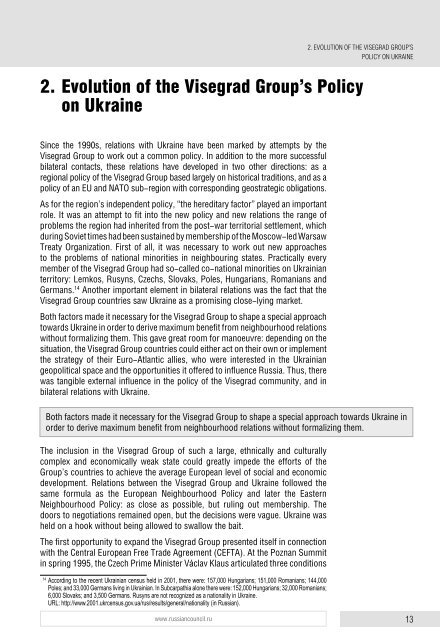2. EVOLUTION OF THE VISEGRAD GROUP’SPOLICY ON UKRAINE2. Evolution of the <strong>Visegrad</strong> Group’s Policyon UkraineSince the 1990s, relations with Ukraine have been marked by attempts by the<strong>Visegrad</strong> Group to work out a common policy. In addition to the more successfulbilateral contacts, these relations have developed in two other directions: as aregional policy of the <strong>Visegrad</strong> Group based largely on historical traditions, and as apolicy of an EU and NATO sub-region with corresponding geostrategic obligations.As for the region’s independent policy, “the hereditary factor” played an importantrole. It was an attempt to fit into the new policy and new relations the range ofproblems the region had inherited from the post-war territorial settlement, whichduring Soviet times had been sustained by membership of the Moscow-led WarsawTreaty Organization. First of all, it was necessary to work out new approachesto the problems of national minorities in neighbouring states. Practically everymember of the <strong>Visegrad</strong> Group had so-called co-national minorities on Ukrainianterritory: Lemkos, Rusyns, Czechs, Slovaks, Poles, Hungarians, Romanians andGermans. 14 Another important element in bilateral relations was the fact that the<strong>Visegrad</strong> Group countries saw Ukraine as a promising close-lying market.Both factors made it necessary for the <strong>Visegrad</strong> Group to shape a special approachtowards Ukraine in order to derive maximum benefit from neighbourhood relationswithout formalizing them. This gave great room for manoeuvre: depending on thesituation, the <strong>Visegrad</strong> Group countries could either act on their own or implementthe strategy of their Euro-Atlantic allies, who were interested in the Ukrainiangeopolitical space and the opportunities it offered to influence Russia. Thus, therewas tangible external influence in the policy of the <strong>Visegrad</strong> community, and inbilateral relations with Ukraine.Both factors made it necessary for the <strong>Visegrad</strong> Group to shape a special approach towards Ukraine inorder to derive maximum benefit from neighbourhood relations without formalizing them.The inclusion in the <strong>Visegrad</strong> Group of such a large, ethnically and culturallycomplex and economically weak state could greatly impede the efforts of theGroup’s countries to achieve the average European level of social and economicdevelopment. Relations between the <strong>Visegrad</strong> Group and Ukraine followed thesame formula as the European Neighbourhood Policy and later the EasternNeighbourhood Policy: as close as possible, but ruling out membership. Thedoors to negotiations remained open, but the decisions were vague. Ukraine washeld on a hook without being allowed to swallow the bait.The first opportunity to expand the <strong>Visegrad</strong> Group presented itself in connectionwith the Central European Free Trade Agreement (CEFTA). At the Poznan Summitin spring 1995, the Czech Prime Minister Václav Klaus articulated three conditions14According to the recent Ukrainian census held in 2001, there were: 157,000 Hungarians; 151,000 Romanians; 144,000Poles; and 33,000 Germans living in Ukrainian. In Subcarpathia alone there were: 152,000 Hungarians; 32,000 Romanians;6,000 Slovaks; and 3,500 Germans. Rusyns are not recognized as a nationality in Ukraine.URL: http://www.2001.ukrcensus.gov.ua/rus/results/general/nationality (in Russian).www.russiancouncil.ru13
RUSSIA AND THE VISEGRAD GROUP:THE UKRAINIAN CHALLENGEof accession to the common customs space formed by the <strong>Visegrad</strong> Group in1992: the existence of bilateral free-trade treaties with all the CEFTA countries;membership of the Organisation for Economic Cooperation and Development(OECD); and membership of the World Trade Organization (WTO). 15The conditions set by Václav Klaus in the 1990s might have been an official screenconcealing the reluctance of the <strong>Visegrad</strong> Group countries to admit Ukraine intoits ranks in spite of that country’s repeated bids to become a member. 16 Relationswith the <strong>Visegrad</strong> Group have had their ups and downs, and Ukraine could counton attracting the <strong>Visegrad</strong> Group’s attention only when the group was on therise. Since the early 2000s, cooperation has been sustained by inviting Ukrainiangovernment ministers to the meetings of <strong>Visegrad</strong> counterparts, a format thatacquired a new dimension with the creation of the International <strong>Visegrad</strong> Fund in2000. In 2003, the <strong>Visegrad</strong> Group launched a series of consultations on borderissues in the V4+Ukraine format. 17After the <strong>Visegrad</strong> Group joined the European Union in 2004 and the Czech Republic,Hungary, Poland and Slovakia left CEFTA, admitting Ukraine to the <strong>Visegrad</strong>Group became meaningless and cooperation continued under the auspices of theEuropean neighborhood policy. Such cooperation was largely confined to humanitarianprogrammes, i.e. cultural-educational and information matters aimed, as theinitiators of the programme claimed, “at strengthening civil society in that country.” 18The International <strong>Visegrad</strong> Fund stressed the development of links between smalltowns in Ukraine and the <strong>Visegrad</strong> Group countries.Even so, the internal political situation in Ukraine and bilateral relations with thecountry were discussed at various levels within the <strong>Visegrad</strong> Group. Thus, onDecember 7, 2004, a meeting of the <strong>Visegrad</strong> Group Ministers of Foreign Affairsin Krakow issued a statement welcoming the decision of the Supreme Court ofUkraine to annul the results of the second round of the presidential elections andsaying that the <strong>Visegrad</strong> Group countries were ready to support Ukraine in its urgefor democratization and adherence to Euro-Atlantic values. 19 After Polish PresidentAleksander Kwaśniewski intervened in resolving the situation concerning theUkrainian elections, a prolonged period of cooling ensued in Russian–Polish andRussian–Ukrainian relations. Simultaneously, the Russian political establishmentbecame more sceptical towards the <strong>Visegrad</strong> Group in general.On June 10, 2005, the prime ministers of the <strong>Visegrad</strong> Group countries expressedtheir determination at a meeting with Ukrainian Prime Minister Yulia Tymoshenkoat Kazimierz Dolny in Poland to back Kiev in pushing ahead with the earlier planof association with the European Union. 20 On October 10, 2006 a meeting of the15Stindl K. How the Slogan “<strong>Visegrad</strong> Group” Opened the Door to Ukraine // The <strong>Visegrad</strong> Group – A Central EuropeanConstellation. IVF. Bratislava, 2006, p. 99.16Such attempts were repeatedly made following Yushchenko’s 2005 victory in the Ukrainian elections. Another attempt wasmade in 2008. Ibid. pp. 98–100.17Meeting of National <strong>Visegrad</strong> Coordinators in Nyíregyháza (Hungary) in the Framework of the Conference on Cross-BorderCooperation in the V4+Ukraine Format. October 16–17, 2003. URL: http://www.visegradgroup.eu/calendar/200318Stindl K. How the Slogan “<strong>Visegrad</strong> Group” Opened the Door to Ukraine // The <strong>Visegrad</strong> Group – A Central EuropeanConstellation. IVF. Bratislava, 2006, p. 100.19Statement of the <strong>Visegrad</strong> Group Ministers of Foreign Affairs on the Situation in Ukraine. December 7, 2004.URL: http://www.visegradgroup.eu/2004/statement-of-the20Joint Declaration of the Prime Ministers of the V4 Countries on Ukraine. Kazimierz Dolny. June 10, 2005.URL: http://www.visegradgroup.eu/2005/joint-declaration-of-the-11041214 Report 22 / 2015


